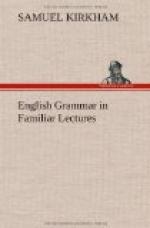cannot comprehend?
Among the various theorists and speculative writers on philosophical grammar, the ingenious Horne Tooke stands pre-eminent; but, unfortunately, his principal speculations on the verb, have never met the public eye. William S. Cardell has also rendered himself conspicuous in the philological field, by taking a bolder stand than any of his predecessors. His view of the verb is novel, and ingeniously supported. The following is the substance of his theory
OF THE VERB.
A verb is a word which expresses
action; as, Man exists; Trees
grow; Waters_flow_;
Mountains stand; I am.
All verbs are active, and have one object or more than one, expressed or implied. The pillar stands; that is, it keeps itself in an erect or standing posture; it upholds or sustains itself in that position. They are; i.e. they air themselves, or breathe air; they inspirit, vivify, or uphold themselves by inhaling air.
Many verbs whose objects are seldom expressed, always have a persona or verbal one implied. The clouds move; i.e. move themselves along. The troops marched twenty miles a day; i.e. marched themselves. The moon shines:—The moon shines or sheds a shining, sheen, lustre, or brightness. The sparrow flies:—flies or takes a flight. Talkers talk or speak words or talk; Walkers walk walkings or walks; The rain rains rain; Sitters sit or hold sittings or sessions.
To prove that there is no
such thing as a neuter verb, the following
appear to be the strongest
arguments adduced.
1. No portion of matter is ever in a state of perfect quiescence; but the component parts of every thing are at all times “influenced by different, active principles, tending to produce change.” Hence, it follows, that no being or thing can be represented in a neuter or non-acting state.
This argument supposes the essential character of the verb to be identified with the primary laws of action, as unfolded by the principles of physical science. The correctness of this position may be doubted; but if it can be clearly demonstrated, that every particle of matter is always in motion, it does not, by any means, follow, that we cannot speak of things in a state of quiescence. What is false in fact may be correct in grammar. The point contested, is not whether things always act, but whether, when we assert or affirm something respecting them, we always represent them as acting.
2. Verbs were originally used to express the motions or changes of things




